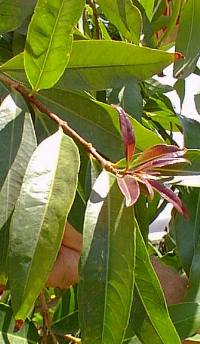Sunset®: 18-24
Frost Tolerance: Semi hardy in Phoenix (to 28° F, -2° C)
Sun Exposure: Full sun
Origin: East Indies
Growth Habits: Evergreen tree to 25 feet (7.5 m)
Watering Needs: Regular water
Propagation: Seeds, budding, air layering
The Rose Apple, native to the East Indies, forms a handsome evergreen tree 25 to 30 feet high, which is prized as an ornamental. The glossy, leathery leaves are lanceolate and pointed, being 6 to 8 inches in length (15-20 cm) and 2 inches or less (5 cm) in width. The new leaves are wine colored and gradually turn to the characteristic dark green at maturity.
Blooming Habits:
The flowers are produced in short terminal racemes on the young branchlets and have many conspicuous greenish white stamens about 1.5 inches in length (3 cm).
Fruiting Habits:
The ovoid or globular fruits are up to 2 inches in length and are white or pale yellow, usually with a faint pink blush. The fruit has a thin layer of pale yellow flesh and 1 to 3 brown seeds, which lie loose in a large, hollow seed cavity. The flesh is rose scented, crisp, juicy and sweet. It is sometimes eaten out of hand but is more generally used to make jelly and jams. It can be stewed or preserved in syrup.
Culture:
The rose apple grows well on a wide range of soil types. It grows rather slowly, and come into bearing in 4 to 5 years from seed. Select strains may be propagated by budding.
Propagation:
The rose apple usually is propagated by seeds, which remain viable for only a short time after being removed from the fruit. The seeds are unusual in that they are poly embryonic - as many as 7 or 8 plants may arise from a single seed.
Desert-Tropicals is dedicated to provide gardening advice, gardening ideas, and information about flower of all kind for landscape and collections.We try to check carefully the identification of the plants on the illustrations as well as the other information from the page, but occasionally errors do occur. if you notice anything that needs to be changed please contact us.Thanks.
© 1998-2020 Philippe Faucon, All Rights Reserved.
